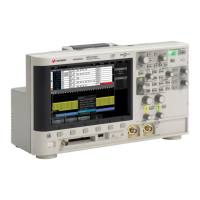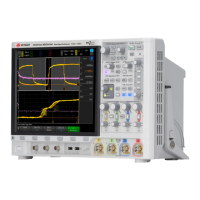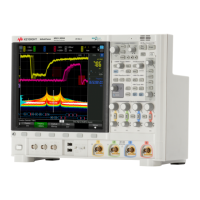398 Keysight InfiniiVision 3000T X-Series Oscilloscopes Programmer's Guide
18 :FUNCtion<m> Commands
:FUNCtion<m>:SOURce1
(see page 1276)
Command Syntax
:FUNCtion<m>:SOURce1 <value>
<m> ::= 1 to (# math functions) in NR1 format
<value> ::= {CHANnel<n> | FUNCtion<c> | MATH<c> | BUS<b>}
<n> ::= 1 to (# analog channels) in NR1 format
<c> ::= {1 | 2 | 3}, must be lower than <m>
<b> ::= {1 | 2}
The :FUNCtion<m>:SOURce1 command is used for any :FUNCtion<m>:OPERation
selection. This command selects the first source for the operator math functions or
the single source for the transform functions, filter functions, or visualization
functions.
The FUNCtion<c> or MATH<c> parameters are available for the transform
functions, filter functions, and the magnify visualization function (see
"Introduction to :FUNCtion<m> Commands" on page 368) when <c> is lower than
<m>.
In other words, higher math functions can operate on lower math functions when
using operators other than the simple arithmetic operations (+, - , *, /). For
example, if :FUNCtion1:OPERation is a SUBTract of CHANnel1 and CHANnel2, the
:FUNCtion2:OPERation could be set up as a FFT operation on the FUNCtion1
source. These are called cascaded math functions.
To cascade math functions, select the lower math function using the
:FUNCtion<m>:SOURce1 command.
When cascading math functions, to get the most accurate results, be sure to
vertically scale lower math functions so that their waveforms take up the full
screen without being clipped.
The BUS<m> parameter is available for the bus charting visualization functions.
Query Syntax
:FUNCtion<m>:SOURce1?
The :FUNCtion<m>:SOURce1? query returns the current source1 for function
operations.
Return Format
<value><NL>
<value> ::= {CHAN<n> | FUNCtion<c> | MATH<c> | BUS<b>}
<n> ::= 1 to (# analog channels) in NR1 format
Another shorthand notation for SOURce1 in this command/query (besides SOUR1) is SOUR.

